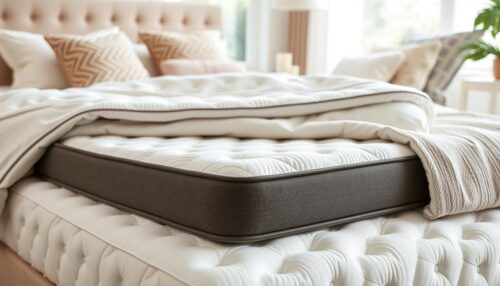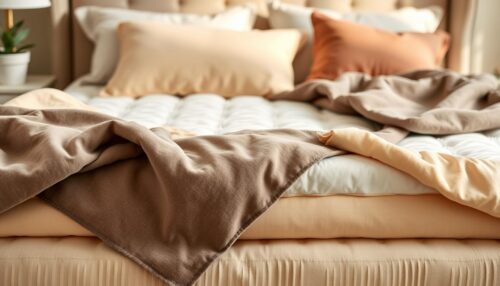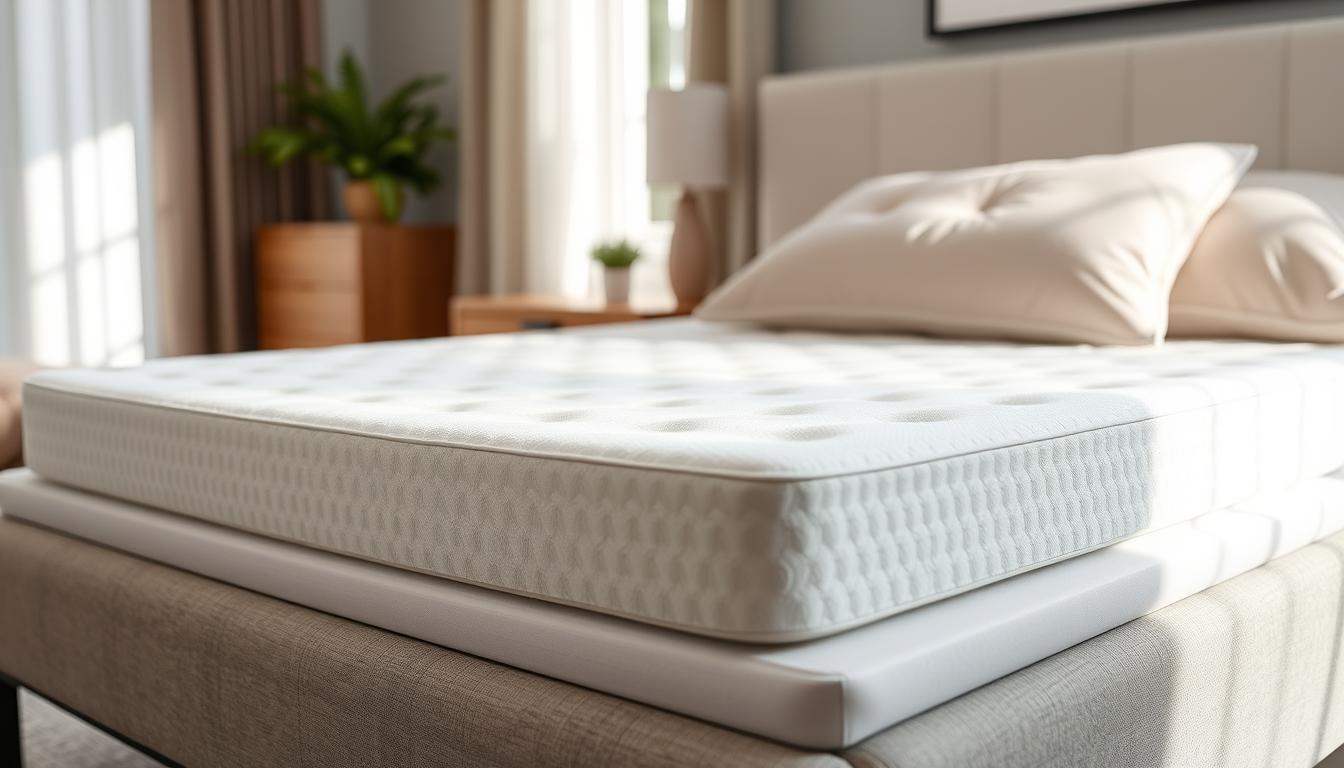Disclosure
This website is a participant in the Amazon Services LLC Associates Program, an affiliate advertising program designed to provide a means for us to earn fees by linking to Amazon.com and affiliated sites.
Many people wonder if a memory foam mattress topper needs a cover. Memory foam molds to your body, giving you pressure relief. But, it can hold heat and stain easily. A cover can make your topper last longer and be easier to clean.
Yet, some like sleeping directly on the foam for better feel. Let’s look at the good and bad of using a cover on your memory foam mattress topper.
Key Takeaways
- Memory foam mattress toppers can benefit from covers for protection against spills, stains, and allergens.
- Covers can enhance comfort and extend the topper’s lifespan, but some users prefer direct contact with the memory foam.
- Discussions on the Mattress Underground forum highlight the tradeoffs between using a cover and the impact on memory foam performance.
- Choosing the right cover can be a balance between protection, comfort, and cost considerations.
- Proper care and maintenance of both the topper and its cover are essential for a comfortable and long-lasting sleep setup.
What is a Memory Foam Mattress Topper?
A memory foam mattress topper is a layer of foam, 1-4 inches thick. It’s made to fit your body and give you pressure relief. It can make a firm mattress softer and more comfy.
Adding a memory foam topper can improve your sleep. It adds cushioning and support, making your sleep better.
Understanding Memory Foam Material
Memory foam, or viscoelastic foam, was introduced in the mid-1990s. It molds to your body, giving you support and relief. It’s different from regular foam because it takes longer to adjust, fitting your body better.
Benefits of Using a Mattress Topper
- Improved comfort and pressure relief for sensitive areas like the shoulders, hips, and back
- Enhanced spinal alignment and support, helping to alleviate aches and pains
- Increased temperature regulation, as some memory foam types like gel-infused or graphite-infused options can help wick away heat
- Reduced motion transfer, allowing for undisturbed sleep for couples
- Extended lifespan of an older mattress by adding a fresh layer of cushioning
Looking to make your mattress better? A memory foam topper can change your sleep for the better. It’s great for your comfort and health.
Purpose of a Cover for Your Mattress Topper
Getting a good mattress topper can make your bed much more comfortable. But, to keep it in great shape, you need a protective cover. This cover does more than just look good. It helps your sleep and makes your topper last longer.
Protection from Spills and Stains
Spills or stains on your topper can be hard to clean and might damage it. A waterproof cover keeps liquids out, protecting your topper. This keeps it clean and safe for you to sleep on.
Keeping Dust Mites and Allergens Away
Dust mites and pet dander can make your topper a problem for people with allergies. A hypoallergenic mattress topper covers keeps these out. This makes your sleep area cleaner and healthier, helping you sleep better.
Pros of Using a Cover
Getting a top-notch memory foam mattress topper cover brings big pluses to your sleep area. One key benefit is it makes your memory foam topper last longer.
Enhances Longevity of the Topper
A cover protects your memory foam topper from damage. It keeps it safe from spills, wear, and other things that can harm it. This way, your cover helps your topper stay comfy and supportive for many years.
Easier Maintenance and Cleaning
Covers are simpler to care for than the topper itself. They can usually be washed in a machine. This makes it easy to keep them clean and fresh. It’s great for stopping sweat, dead skin, and other stuff from building up.
With a mattress topper protection cover, you keep your topper clean and in good shape. This ensures it keeps giving you the comfort and support you need for a great sleep.
Cons of Using a Cover
Using a mattress topper cover has its downsides. One issue is it might make your bed warmer. Memory foam toppers adjust to your body heat for comfort. But a cover could make it feel harder than you want.
Some covers, made of less breathable materials, can trap heat. This is bad for people who sleep hot or live in warm places. Look for covers with cooling features like moisture-wicking fabrics or holes for air.
Potential for Increased Heat Retention
A cover can make your memory foam topper feel firmer. It might also make your bed warmer. This is a problem for those who sleep hot.
Additional Cost to Consider
Buying a good mattress topper cover costs extra. It’s an investment in your topper’s life, but it adds to your budget. Still, a well-protected topper is worth the money in the long run.
Types of Mattress Topper Covers
Choosing the right cover for your memory foam mattress topper is key. Covers come in different fabrics, each with its own benefits. We’ll look at the options and the differences between water-resistant and waterproof covers.
Fabric Options Available
The most common materials for mattress topper covers are:
- Polyester – A synthetic fabric that’s durable, easy to clean, and affordable.
- Organic Cotton – A natural, breathable fabric that’s soft and good for allergies.
- Vinyl – A waterproof material that keeps spills and stains away.
- Polyurethane – A synthetic material that can be water-resistant or waterproof.
Water-Resistant vs. Waterproof Covers
Choosing a cover depends on how much protection you need. Water-resistant covers protect against small spills and moisture. Waterproof covers keep your mattress topper dry and clean from all liquids.
Water-resistant covers let air in, helping with temperature and airflow. Waterproof covers block liquid but might not breathe as well.
So, whether to choose water-resistant or waterproof mattress topper covers depends on your needs and preferences. It also depends on the sleep environment you want to create.
How to Choose the Right Cover
Choosing the right cover for your memory foam mattress topper is key to better sleep. Think about your sleep habits and budget when picking a cover.
Consider Your Sleeping Habits
Think about how you sleep. If you sweat a lot or spill drinks, pick a cover that’s breathable and water-resistant. Breathable mattress topper covers keep you cool and comfortable all night.
Budget Considerations
Don’t forget about your budget. You want a good cover that’s not too expensive. Look for ones that are durable, comfy, and won’t break the bank. Think about how long it lasts and how easy it is to clean.
By thinking about your sleep habits and budget, you can pick the best memory foam mattress topper covers. The right cover will protect and comfort your mattress, giving you a great night’s sleep.

When You Might Not Need a Cover
For memory foam mattress toppers, you might not always need a cover. If you have a good mattress protector that covers the topper, you might not need another one. Mattress protectors keep your bedding safe from spills, stains, and allergens.
For short-term use, like in guest rooms, you might not need a cover. These situations don’t need as much protection. But, a cover still helps keep your topper safe and lasts longer.
If You Use a Mattress Protector
- Good mattress protectors keep your topper safe from spills, stains, and allergens.
- If you already have a protective cover, you might not need another one. The protector does the job.
Short-Term Use Situations
- In guest rooms or for temporary beds, you might not need a special topper cover.
- But, a cover still adds protection and makes your topper last longer.
Whether or not to use a cover for your memory foam mattress topper depends on your needs. Think about how much protection you need, how often you use it, and your sleep setup. This will help you decide if a cover is worth it.
Care Instructions for Your Mattress Topper
Keeping your memory foam mattress topper clean is key for its long life and your comfort. We’ll cover how to wash the cover and clean the topper itself.
Washing Your Cover
Most covers can be washed in a machine. Use warm or cold water and gentle, eco-friendly detergents. For tough stains, try a baking soda paste first.
Don’t use harsh chemicals or bleach. They can harm the memory foam.
Cleaning the Topper Itself
Spot clean the topper every three months or when needed. Use a mild detergent or an enzymatic spray for spills. Never soak the topper in water.
Vacuum it to get rid of dust and dirt. Let it dry fully before using it again.
By following these tips, your topper will last longer and stay comfy. Spot cleaning and occasional deep cleaning will keep it in top shape.
Signs You Need a New Mattress Topper Cover
Your memory foam mattress topper adds comfort and support. But, the cover can wear out over time. It’s important to know when to replace it to keep your sleep area clean and comfy.
Visible Wear and Tear
Look closely at your mattress topper cover. If you see holes, thin fabric, or loose elastics, it’s time for a new one. These problems can let spills and stains damage your topper.
Unpleasant Odors
Even with washing, your cover might start smelling bad. This could mean it’s time for a new one. Bad smells can mean bacteria or mold, harming your memory foam mattress topper care.
Check your cover often for wear and bad smells. Replacing it when needed keeps your mattress topper cover replacement fresh. A good cover helps your topper last longer and work better.
Frequently Asked Questions
There are many questions about mattress toppers. Let’s answer some of the most common ones.
Do All Mattresses Require Covers?
Not all mattresses need covers. Mattress topper covers are good for most mattresses, but not all. It depends on the mattress type, your likes, and how much protection you need.
For example, memory foam mattress toppers might need a cover more. It helps them last longer and stay clean.
How Often Should You Change Your Cover?
- It’s wise to change your mattress topper covers every 1-2 years.
- But, how often depends on how much you use it, stains, or wear.
- For the best memory foam mattress topper care, wash the cover every 2-4 weeks. This keeps it fresh and clean.
- Having extra covers is smart. This way, you can wash one while using another. This keeps your sleep area always fresh.
Watching your mattress topper cover’s condition and changing it when needed is key. It helps your mattress topper last longer and keeps your sleep area clean and comfy.

Conclusion: Should You Use a Cover?
Using a cover for your memory foam mattress topper has many benefits. It protects, keeps things clean, and makes your topper last longer. But, it might make your topper feel a bit less responsive. Think about what you need, how you sleep, and your budget before deciding.
Weighing the Benefits vs. Drawbacks
A cover keeps your topper safe from spills, stains, and dust mites. It also makes cleaning up easier. But, it might make your topper feel less conforming and responsive. Decide if the benefits of protection and ease outweigh the slight change in feel.
Making the Best Choice for Your Sleep Setup
Choosing to use a cover for your memory foam mattress topper depends on you. If you want your topper to last longer and stay clean, a cover is a good choice. But, if you like the topper’s original feel, you might not want a cover. Think about your budget, how you sleep, and your topper’s features to make the best choice for you.

